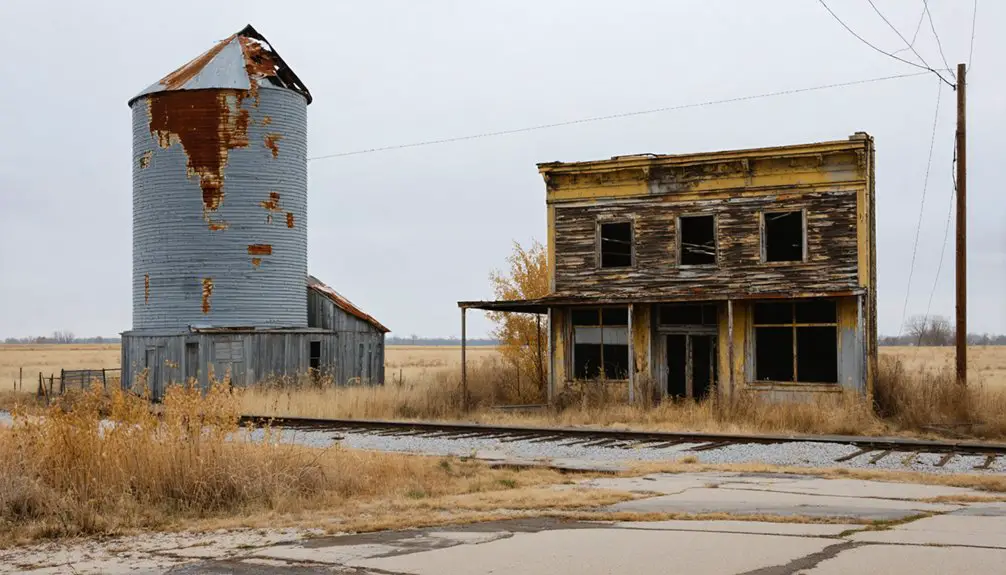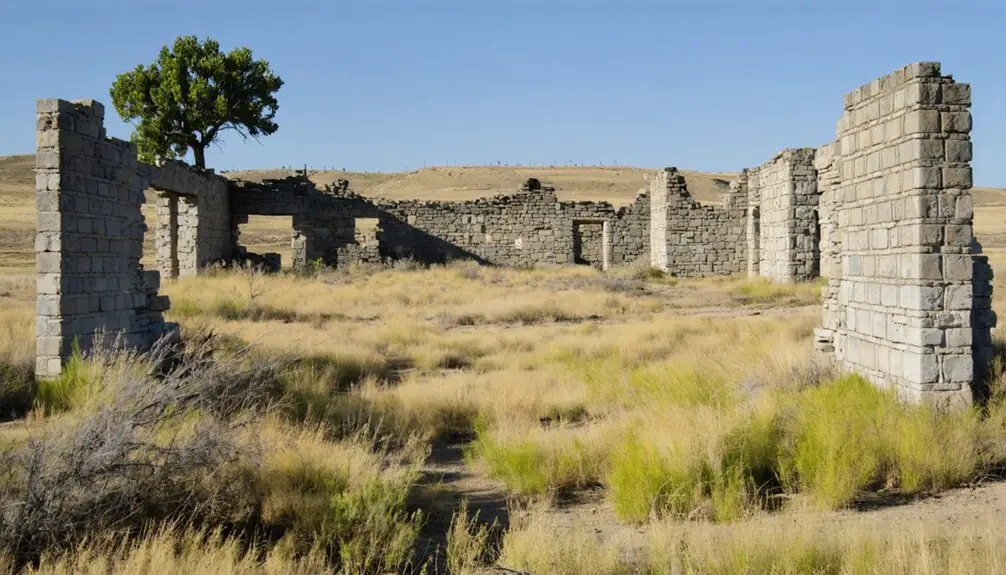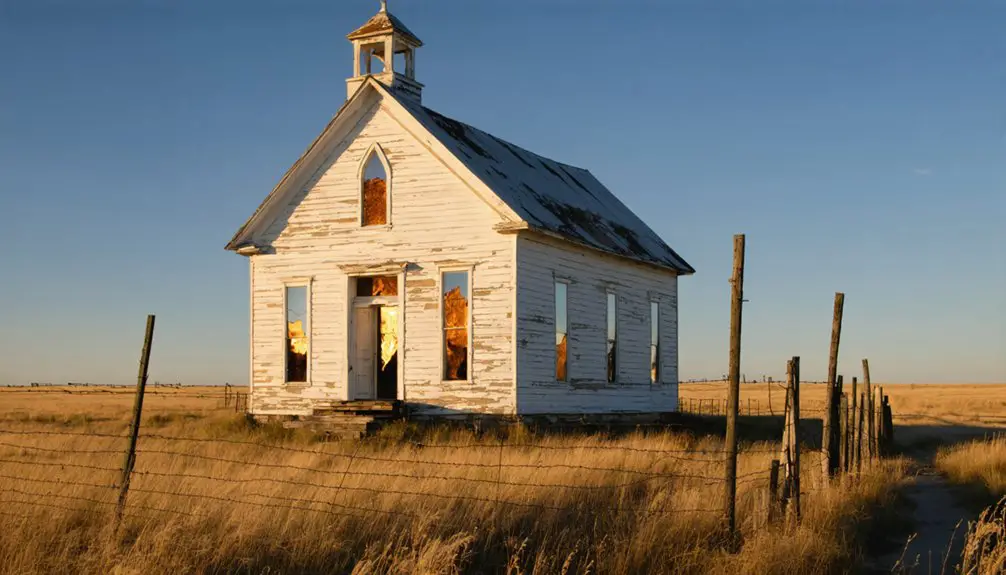You’ll find Palermo’s ghost town story began as a promising Kansas Territory settlement in 1854, attracting diverse settlers with dreams of becoming a major transportation hub. The town’s initial growth centered around its steamboat landing and ambitious railroad plans, including the Bob-Trail Railroad project. However, failed rail connections, economic troubles, and Civil War disruptions led to its decline by the early 1900s. Today, only scattered ruins and cemetery headstones hint at the fascinating frontier tales waiting to be discovered.
Key Takeaways
- Palermo was established in 1854 as a frontier settlement in Kansas Territory with ambitious plans to become a transportation hub.
- The town’s decline began when the Bob-Trail Railroad and other rail plans failed, leaving it isolated from major transportation routes.
- Economic factors, including failed investments, Civil War disruption, and farming changes, contributed to Palermo’s transformation into a ghost town.
- A vibrant community once existed with general stores, steamboat landings, and diverse residents before its eventual abandonment.
- Today, only ruins of a capital building, scattered artifacts, and cemetery headstones remain as evidence of Palermo’s frontier past.
The Rise of a Frontier Settlement
As Kansas Territory opened for settlement in 1854, Palermo emerged as a strategic frontier outpost positioned near the convergence of major westward routes including the Santa Fe and Oregon Trails.
You’ll find the town’s roots deeply intertwined with the settlement dynamics of the era, as families rather than lone settlers established homesteads near essential water sources and transportation corridors. The growing community had to navigate the Kansas-Nebraska Act allowing settlers to determine the slavery question through popular sovereignty.
The frontier challenges faced by early residents included adapting to harsh climate conditions while building a thriving agricultural community. Local settlers faced increasing tensions as emigrant behavior led to conflicts with neighboring tribes.
You’d have witnessed German immigrants joining the mix of Free State and pro-slavery settlers after 1860, drawn by fertile soil and affordable land.
The town’s economy flourished by serving westward emigrants, buffalo hunters, and traders moving between Missouri and New Mexico, all while maintaining complex relationships with nearby Native American tribes.
Pre-Civil War Development and Growth
You’ll find Palermo’s early growth was closely tied to ambitious railroad plans, including the 1859 Palermo Railroad agreement and subsequent Bob-Tail Road construction project starting in 1870.
Similar to tensions seen during Bleeding Kansas era, residents were divided between pro-slavery and free-state positions during the town’s formative years.
The promise of rail connectivity sparked optimism among settlers and businesses, temporarily fueling the frontier town’s development through the establishment of stores and other commercial ventures. The town’s bustling Steamboat Landing became a vital hub for trade and transportation during its peak years.
Financial controversies and delays in completing the railroad infrastructure, however, began undermining the settlement’s economic stability even before the outbreak of the Civil War.
Early Railroad Ambitions
During Kansas’s territorial period before the Civil War, railroad development exploded with ambitious plans and numerous charters. You’ll find that about 45 railroad companies emerged during this time, each hoping to establish essential transportation routes or benefit specific towns.
Early railroad ambitions were easy to pursue – for just one dollar, you could obtain a charter to build anywhere in the state. Limited capital and funding made it difficult for most companies to begin actual construction.
Notable ventures included the Eastern Kansas & Gulf Railroad Company, backed by $5,000,000 in capital stock, and the Leavenworth, Pawnee and Western Railroad (later Kansas Pacific) established in 1855. The railroad later received federal land grants to support its expansion across the territory.
The Atchison & Palmetto exemplified these early transportation dreams, raising $1,000,000 to connect Atchison to the Big Blue River.
While many planned routes never materialized, these ambitious charters laid the groundwork for Kansas’s future rail network.
Frontier Settlement Expansion
The vibrant settlement of Palermo emerged alongside dozens of other frontier towns in the 1850s, when the Kansas Territory first opened for settlement.
You’ll find that settlement dynamics were shaped by the Kansas-Nebraska Act, which drew a diverse mix of farmers, traders, and speculators seeking new opportunities on the frontier.
The town’s community resilience was tested during these early years as settlers established farms, general stores, and ambitious plans for institutions like Wayland University. Similar to Bell Plane’s early development, settlers purchased land from the government for 1.25 per acre.
Despite the political tensions between pro-slavery and anti-slavery factions, Palermo’s population worked to build basic social structures including churches and schools.
Like many Kansas settlements that became ghost towns later, the settlement’s rapid growth reflected the optimistic spirit of frontier expansion, though economic challenges like the Panic of 1857 and the looming Civil War would soon test the town’s foundations.
The Bob-Trail Railroad Dream
You’ll find the story of the Bob-Trail Railroad dream intertwined with Palermo’s fate, as this ambitious plan to connect Kansas regional points with larger markets and the Gulf of Mexico fell apart in the late 19th century.
Like many railroad initiatives during Kansas’ development, the venture required a capital stock investment of several million dollars to fund construction and operations.
The vision, backed by significant capital stock and local leaders, mirrored other Kansas railroad expansion efforts like the Eastern Kansas & Gulf Railroad but ultimately failed to materialize. The rapid expansion of competing railroads between 1865 and 1880 left many smaller planned rail projects unable to secure funding.
When the railroad plans collapsed, Palermo’s hopes of becoming a crucial transportation hub diminished, leading to its eventual decline into a ghost town.
Railroad Plans Fall Apart
Despite ambitious plans and substantial promised capital of $5 million, Bob-Trail Railroad‘s dream of connecting Kansas to Texas and the Gulf of Mexico through Indian Territory ultimately crumbled under financial and political pressures.
You’ll find that railroad failures mounted as economic decline swept through the region, with investors growing hesitant amid the political instability of “Bleeding Kansas” and uncertain land rights.
- Competition from established rail companies deterred new investments
- Engineering challenges across Kansas’s rivers and streams complicated construction
- Insufficient funding left partially built or inactive rail segments
- Political tensions and regional conflicts undermined investor confidence
The grand vision of creating a central route to boost economic ties between Kansas and southern states remained unfulfilled, as the Bob-Trail Railroad joined other abandoned charters of the era.
Economic Hopes Derailed
Railroad failures weren’t just about tracks and trains – they represented shattered economic dreams for entire communities.
You can see this clearly in Palermo’s Bob-Trail Railroad saga, where millions in capital stock had been allocated towards a vision of prosperity. Local investors and businessmen committed between $1-5 million, anticipating their town would become an essential transportation hub connecting Kansas to Missouri, Texas, and Gulf routes.
The economic impact of the railroad’s collapse was devastating. Without rail connectivity, you’d have seen Palermo miss significant trade opportunities while nearby towns flourished.
Railroad speculation that once promised to bring commerce, settlers, and agricultural market access instead led to stagnation. The town’s isolation from emerging transportation networks triggered a downward spiral of lost investment and population decline, ultimately contributing to Palermo’s ghost town fate.
Transportation Dreams Fade
While ambitious railroad charters laid the groundwork for Palermo’s transportation future, the reality fell far short of expectations. The transportation evolution you’d have witnessed included multiple companies vying to connect Palermo with key regional destinations like Lecompton and Atchison.
Despite grand plans, these early railroad dreams didn’t materialize as hoped.
- The Palermo & Lecompton charter promised essential connections but never achieved its vision
- Railroad companies faced significant infrastructure challenges in building and maintaining lines
- Pacific expansion plans through Kansas remained unrealized dreams
- Major railroads like Missouri Pacific and Rock Island developed routes that bypassed Palermo
The railroads’ impact on Palermo’s destiny proved disappointing, as the town watched other communities flourish with successful rail connections while its own transportation aspirations gradually faded into obscurity.
Economic Forces Behind the Decline

As economic forces converged in the late 1800s, Palermo’s promising future began to unravel through a complex web of transportation setbacks, agricultural changes, and financial instability.
You’ll find that Palermo’s economic decline stemmed from multiple factors hitting simultaneously. When the Bob-Trail Railroad plans fell through, the town lost its shot at becoming a crucial transportation hub.
Meanwhile, farming was changing dramatically – new machinery and methods meant fewer workers needed to work larger farms. These demographic shifts emptied out the countryside as young people moved to cities.
Making matters worse, allegations of financial misconduct among local business leaders created an atmosphere of distrust that scared away new investment.
The Civil War’s lingering effects, including physical damage and disrupted commerce, dealt additional blows to the struggling town’s economy.
Life in Early Palermo Society
Though little remains of Palermo today, records paint a picture of a vibrant frontier society that emerged in the mid-1800s. The community dynamics reflected the era’s rapid growth, with longtime settlers mixing with newcomers and controversial financiers.
You’d have found a society shaped by cultural aspirations, evidenced by plans for Wayland University and bustling commercial activity.
- A diverse population of several hundred residents at its peak created a complex social fabric.
- General stores served as community hubs where citizens gathered and conducted business.
- Economic stratification existed between established residents and incoming business interests.
- Social life centered around commerce and transportation routes, particularly the Bob-Tail Road.
These elements combined to create a typical frontier town atmosphere, where opportunity and uncertainty coexisted amid rapid development and change.
War’s Impact on Town Survival

During the Civil War era, Palermo faced devastating blows that would ultimately seal its fate as a ghost town. You’ll find that Missourians partially burned the town, though local leader John Stewart helped stop their advance. The war legacy left deep scars, disrupting the town’s stability and creating suspicion among residents.
As violence escalated, you can trace how community disintegration accelerated. Residents fled to safer areas, while vital railroad plans shifted away from Palermo. The town’s ambitious plans, including Wayland University, collapsed as war-related uncertainties discouraged investment.
Transportation Networks and Town Fate
While Palermo initially held promise due to its Missouri River location, the town’s ultimate downfall stemmed from critical transportation network failures in the late 19th century.
The uncompleted railroad meant Palermo couldn’t compete with neighboring towns like Wathena and St. Joseph, which attracted commerce through their established transportation routes. This economic isolation led to devastating consequences as businesses, postal services, and residents gradually abandoned the settlement.
- Rail lines bypassed Palermo in favor of other regional hubs
- Stagecoach and mail routes shifted away from the struggling town
- Local businesses couldn’t sustain operations without reliable transport links
- Neighboring towns with railroad stops flourished while Palermo declined
The pattern was clear – without essential transportation connections, Palermo joined numerous other Kansas settlements that faded into ghost town status.
Comparing Palermo to Other Ghost Towns

How did Palermo’s decline compare to other Kansas ghost towns? While Palermo’s demise was driven by financial troubles and railroad setbacks, you’ll find similar economic factors impacted other towns like Empire City, which declined when mining slowed.
Palermo’s struggles share ghost town similarities with Dunlap, as both suffered Civil War attacks that hastened their downfall.
Unlike Piedmont, which maintains visible buildings and grounds, or Empire City, which once boasted 3,000 residents, Palermo never grew beyond a small settlement.
You can see these Palermo comparisons in what remains today – just ruins and a graveyard, while other ghost towns retain more infrastructure.
The town’s lack of a planned university and industrial base left it more vulnerable than communities that had established economic foundations before their decline.
What Remains Today: A Historical Site
Today, Palermo’s remains tell a sparse but intriguing story of its past. You’ll find few standing structures except for remnants of an old capital building.
The site’s artifact significance lies in scattered discoveries like branded bricks and vintage household appliances from the early 1900s, offering glimpses into daily life. Local burial practices are evident in the cemetery, where headstones mainly date from the early 20th century, though earlier unmarked graves likely exist beneath the surface.
- The overgrown site contains fragments of domestic life, including old heaters and multifunction ovens.
- Branded bricks bearing historical product names like “Miss Winslow’s soothing syrup” dot the landscape.
- Cemetery headstones from the 1900s mark the town’s final active period.
- Natural reclamation has taken over, with no formal preservation or visitor infrastructure in place.
Frequently Asked Questions
What Happened to John Stewart After He Saved Palermo From Destruction?
Like dust in the prairie wind, John Stewart’s legacy fades into mystery. You won’t find records of his life after saving Palermo, though his actions shaped the town’s historical significance.
Were There Any Notable Crimes or Outlaws Associated With Palermo?
You won’t find major outlaw legends in Palermo’s crime history. The town mainly dealt with crooked railroad financiers and Civil War-era unrest rather than notorious criminals or violent gangs.
Did Any Native American Tribes Have Settlements Near Palermo?
Like ripples in time, you’ll find the Kanza (Kaw) tribe’s Native settlements were closest to Palermo’s location, while the Osage and Pawnee tribes left their cultural influence in surrounding territories.
What Was the Peak Population of Palermo During Its Brief Existence?
You’ll find that during its ghost town history, Palermo reached over 600 residents at its peak before population decline took hold in the early 1900s when mining operations began shutting down.
Are There Any Artifacts From Palermo Preserved in Kansas Museums?
While you’ll find a weathered heater and old oven discovered at Palermo’s site, plus a Miss Winslow’s soothing syrup bottle, there’s no documented collection of artifacts in Kansas museums today.
References
- https://www.youtube.com/watch?v=cApROIIoTuY
- https://www.hhhistory.com/2019/05/ghost-towns-of-kansas.html
- https://lostkansas.ccrsdigitalprojects.com/sites/lostkansas/files/private_static/2022-12/LT_DP_GearyCity_Laroff.pdf
- https://www.youtube.com/watch?v=alC1wDdSVvg
- https://legendsofkansas.com/kansas-ghost-town-list/
- https://en.wikipedia.org/wiki/History_of_Kansas
- https://www.kspatriot.org/index.php/articles/16-territorial-kansas/624-kansas-and-the-indian-frontier.html
- https://legendsofkansas.com/first-kansas-settlements/
- https://www.youtube.com/watch?v=F-eLk9802LI
- https://keep.konza.k-state.edu/handbookdocuments/Early Kansas Settlement – 2012.pdf



